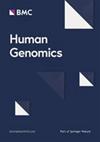剖析m6A效应因子在多能性重编程调控中的作用
IF 3.8
3区 医学
Q2 GENETICS & HEREDITY
引用次数: 0
摘要
N6-甲基腺苷(m6A)RNA修饰在多种生物过程中发挥着重要作用,包括干细胞命运的决定。为了探索m6A修饰在多能性重编程中的作用,我们使用RNA-seq绘制了人类iPSCs、成纤维细胞、H9 ESCs以及小鼠ESCs和成纤维细胞中的m6A效应因子。通过整合人类和小鼠的RNA-seq数据,我们发现19个m6A效应因子在重编程过程中显著上调。值得注意的是,IGF2BPs,尤其是IGF2BP1,是多能细胞中上调最多的基因之一,而YTHDF3在成纤维细胞中有高水平的表达。通过定量 PCR 和 Western 印迹,我们验证了与多能性相关的 IGF2BPs 的升高。敲除 IGF2BP1 会诱导干性基因下调并退出多能性。对重编程过程初期和末期收集的细胞进行的蛋白质组分析表明,IGF2BP1蛋白与干性标志物SOX2和OCT4呈正相关。eCLIP-seq目标分析显示,IGF2BP1与SOX2转录本的编码序列(CDS)和3'UTR区域相互作用,这与m6A修饰的位置一致。这项研究确定了 IGF2BP1 是与多能性相关的重要 m6A 效应因子,为 m6A 表观遗传修饰与多能性重编程之间的相互作用提供了新的视角。本文章由计算机程序翻译,如有差异,请以英文原文为准。
Profiling the role of m6A effectors in the regulation of pluripotent reprogramming
The N6-methyladenosine (m6A) RNA modification plays essential roles in multiple biological processes, including stem cell fate determination. To explore the role of the m6A modification in pluripotent reprogramming, we used RNA-seq to map m6A effectors in human iPSCs, fibroblasts, and H9 ESCs, as well as in mouse ESCs and fibroblasts. By integrating the human and mouse RNA-seq data, we found that 19 m6A effectors were significantly upregulated in reprogramming. Notably, IGF2BPs, particularly IGF2BP1, were among the most upregulated genes in pluripotent cells, while YTHDF3 had high levels of expression in fibroblasts. Using quantitative PCR and Western blot, we validated the pluripotency-associated elevation of IGF2BPs. Knockdown of IGF2BP1 induced the downregulation of stemness genes and exit from pluripotency. Proteome analysis of cells collected at both the beginning and terminal states of the reprogramming process revealed that the IGF2BP1 protein was positively correlated with stemness markers SOX2 and OCT4. The eCLIP-seq target analysis showed that IGF2BP1 interacted with the coding sequence (CDS) and 3’UTR regions of the SOX2 transcripts, in agreement with the location of m6A modifications. This study identifies IGF2BP1 as a vital pluripotency-associated m6A effector, providing new insight into the interplay between m6A epigenetic modifications and pluripotent reprogramming.
求助全文
通过发布文献求助,成功后即可免费获取论文全文。
去求助
来源期刊

Human Genomics
GENETICS & HEREDITY-
CiteScore
6.00
自引率
2.20%
发文量
55
审稿时长
11 weeks
期刊介绍:
Human Genomics is a peer-reviewed, open access, online journal that focuses on the application of genomic analysis in all aspects of human health and disease, as well as genomic analysis of drug efficacy and safety, and comparative genomics.
Topics covered by the journal include, but are not limited to: pharmacogenomics, genome-wide association studies, genome-wide sequencing, exome sequencing, next-generation deep-sequencing, functional genomics, epigenomics, translational genomics, expression profiling, proteomics, bioinformatics, animal models, statistical genetics, genetic epidemiology, human population genetics and comparative genomics.
 求助内容:
求助内容: 应助结果提醒方式:
应助结果提醒方式:


